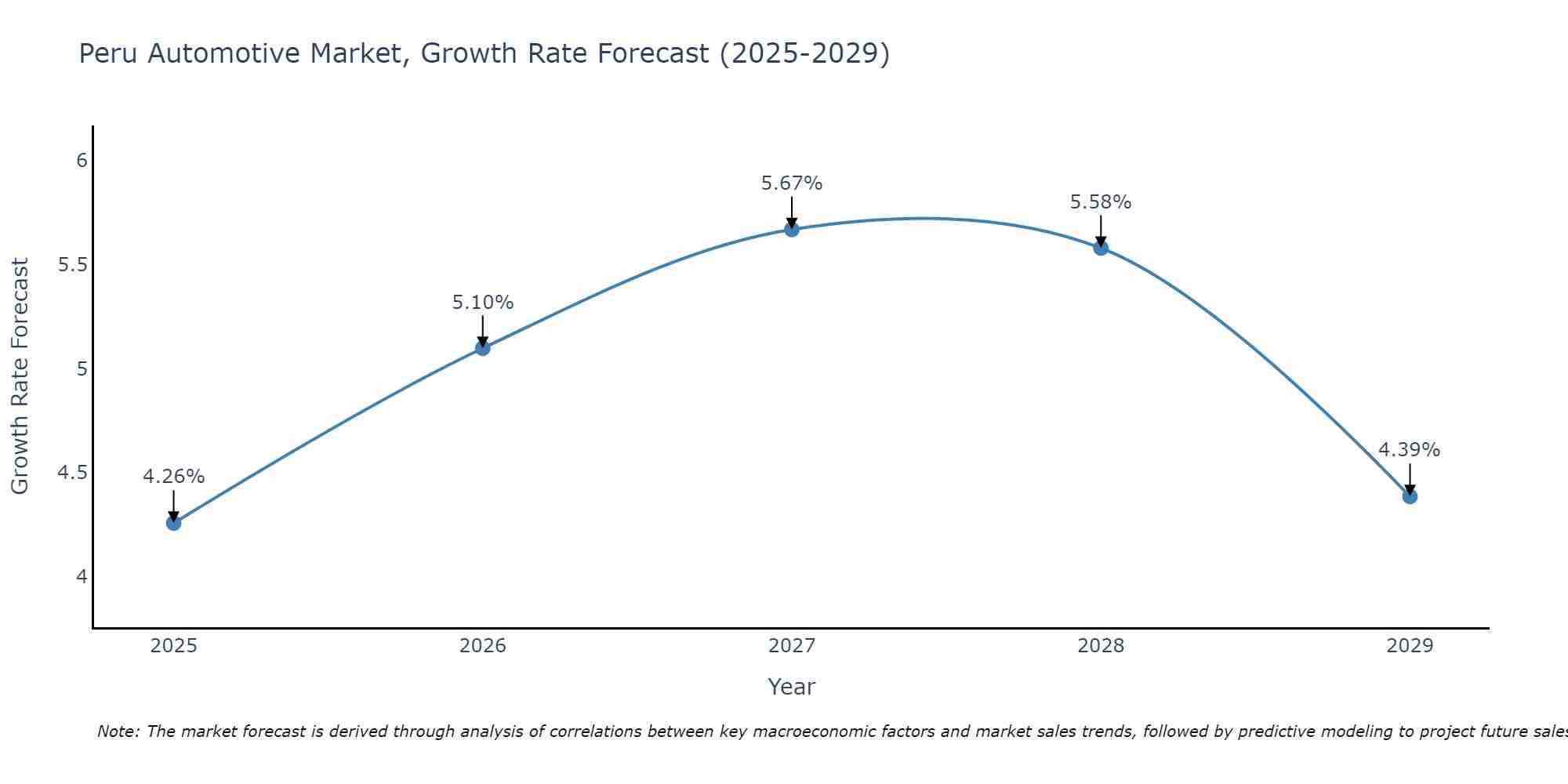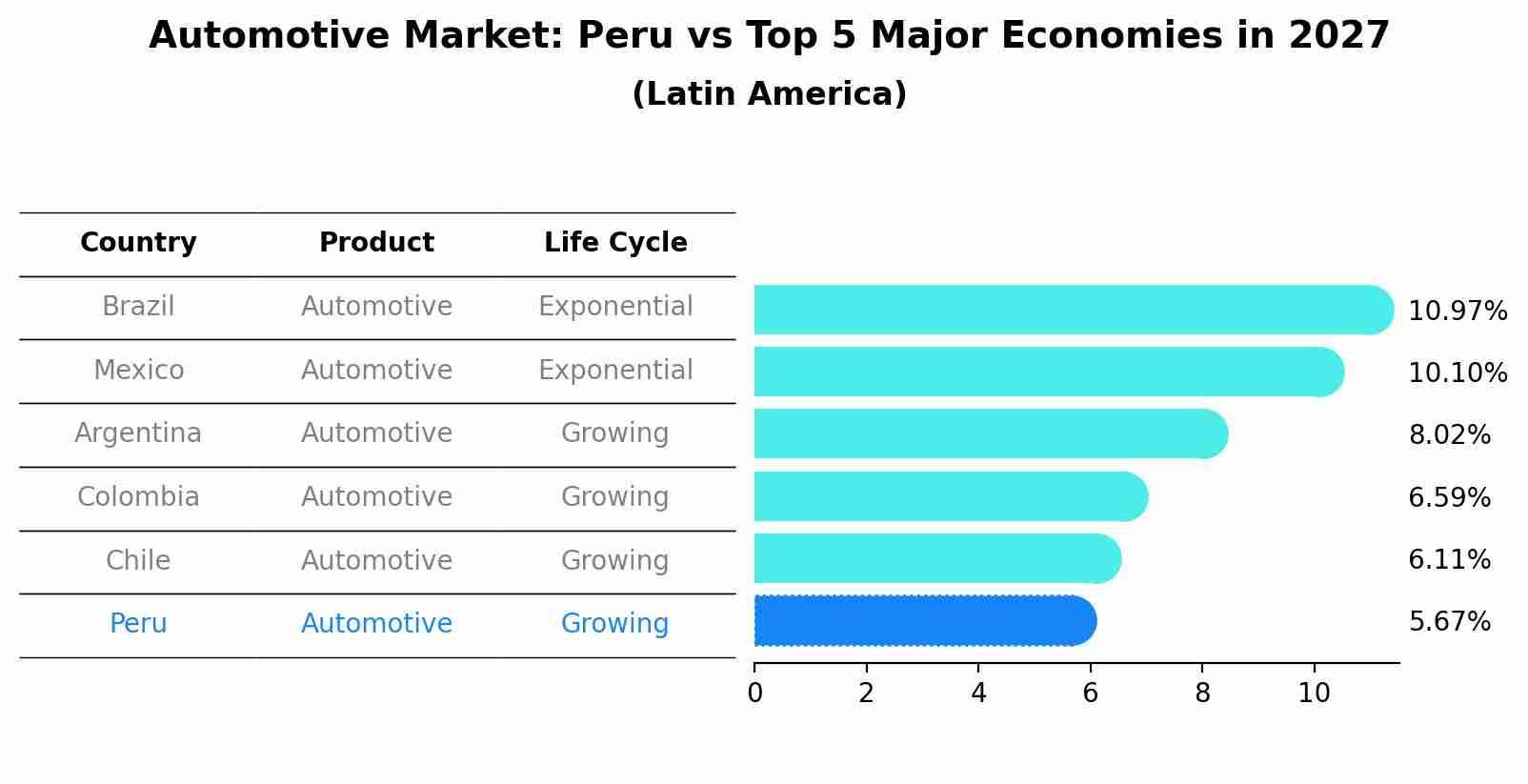Peru Automotive Market Outlook | Size, Analysis, Share, Value, Trends, Growth, Revenue, COVID-19 IMPACT, Forecast, Companies & Industry
| Product Code: ETC431762 | Publication Date: Oct 2022 | Updated Date: Jul 2025 | Product Type: Market Research Report | |
| Publisher: 6Wresearch | Author: Bhawna Singh | No. of Pages: 75 | No. of Figures: 35 | No. of Tables: 20 |
Peru Automotive Market Size Growth Rate
The Peru Automotive Market is projected to witness mixed growth rate patterns during 2025 to 2029. The growth rate begins at 4.26% in 2025, climbs to a high of 5.67% in 2027, and moderates to 4.39% by 2029.

Automotive Market: Peru vs Top 5 Major Economies in 2027 (Latin America)
By 2027, Peru's Automotive market is forecasted to achieve a growing growth rate of 5.67%, with Brazil leading the Latin America region, followed by Mexico, Argentina, Colombia and Chile.

Peru Automotive Market Synopsis
The Peru automotive market is witnessing steady growth driven by increasing disposable income, urbanization, and infrastructure development. The market is dominated by compact cars, with Japanese brands such as Toyota, Nissan, and Suzuki leading in sales. SUVs and crossovers are also gaining popularity among Peruvian consumers. The used car market is significant in Peru, offering affordable options for buyers. Electric vehicles are gradually making inroads, supported by government incentives and a growing environmental awareness among consumers. Despite challenges such as traffic congestion and air pollution in major cities like Lima, the automotive market in Peru presents opportunities for both domestic and international manufacturers to expand their presence and introduce innovative, eco-friendly vehicles to cater to the evolving needs of consumers.
Peru Automotive Market Trends
In the Peru Automotive Market, there is a growing demand for electric and hybrid vehicles as consumers are increasingly conscious of environmental sustainability. Government incentives and initiatives promoting the adoption of eco-friendly vehicles have further accelerated this trend. Additionally, there is a rising interest in advanced safety features and technology integration in vehicles, driving automakers to introduce more sophisticated models in the market. The shift towards online car sales and digital platforms for vehicle research and purchases is also gaining momentum, providing consumers with greater convenience and accessibility. Overall, the Peru Automotive Market is witnessing a transformation towards more sustainable, technologically advanced, and digitally driven trends.
Peru Automotive Market Challenges
In the Peru Automotive Market, several challenges are faced, including high import taxes and tariffs on vehicles, which can drive up the overall cost of cars for consumers. Additionally, infrastructure issues such as poor road conditions and lack of developed transportation networks can hinder the growth of the automotive industry. Competition from used car sales and informal markets also presents a challenge for new car sales. Furthermore, economic instability and fluctuations in currency exchange rates can impact consumer purchasing power and confidence in making big-ticket purchases like cars. Overall, navigating these challenges requires strategic planning and adaptation by automotive companies looking to succeed in the Peru market.
Peru Automotive Market Investment Opportunities
The Peru automotive market presents promising investment opportunities due to increasing demand for vehicles fueled by a growing middle class and improving economic conditions. Opportunities exist in various segments such as new car sales, used car sales, automotive parts and accessories, and aftermarket services. Foreign automakers are increasingly entering the market, leading to competition and technological advancements. Additionally, the government has implemented measures to promote the automotive industry, such as tax incentives for local production and the renewal of the vehicle fleet. Investing in distribution and dealership networks, as well as exploring partnerships with local manufacturers, can be lucrative strategies for tapping into the potential of the Peru automotive market.
Jordan Agar Market Government Policies
The Peruvian government has implemented various policies to support the automotive market, including tax incentives and trade agreements to promote the industry`s growth. In recent years, the government has focused on reducing import tariffs on vehicles to make them more affordable for consumers and stimulate domestic production. Additionally, initiatives such as the "Plan Renova" program have been introduced to encourage the renewal of older vehicles with more fuel-efficient and environmentally friendly models. The government is also working on improving infrastructure and regulations to enhance road safety and reduce emissions. Overall, these policies aim to boost the automotive sector`s competitiveness, increase investments, and drive technological advancements in Peru`s transportation industry.
Peru Automotive Market Future Outlook
The future outlook for the Peru Automotive Market appears promising, with continued growth expected in the coming years. Factors such as a growing middle-class population, increasing urbanization, and rising disposable incomes are likely to drive consumer demand for vehicles. Additionally, government initiatives to improve infrastructure and promote the use of electric vehicles could further boost the market. The increasing focus on sustainable and eco-friendly transportation options is also anticipated to influence consumer preferences in the automotive sector. Overall, the Peru Automotive Market is poised for expansion, with opportunities for both domestic and international automotive manufacturers to capitalize on the evolving consumer trends and market dynamics in the country.
Key Highlights of the Report:
- Peru Automotive Market Outlook
- Market Size of Peru Automotive Market, 2021
- Forecast of Peru Automotive Market, 2031
- Historical Data and Forecast of Peru Automotive Revenues & Volume for the Period 2018 - 2031
- Peru Automotive Market Trend Evolution
- Peru Automotive Market Drivers and Challenges
- Peru Automotive Price Trends
- Peru Automotive Porter's Five Forces
- Peru Automotive Industry Life Cycle
- Historical Data and Forecast of Peru Automotive Market Revenues & Volume By Product Type for the Period 2018 - 2031
- Historical Data and Forecast of Peru Automotive Market Revenues & Volume By Electric for the Period 2018 - 2031
- Historical Data and Forecast of Peru Automotive Market Revenues & Volume By Hybrid Electric for the Period 2018 - 2031
- Historical Data and Forecast of Peru Automotive Market Revenues & Volume By Plug-In Hybrid Electric for the Period 2018 - 2031
- Historical Data and Forecast of Peru Automotive Market Revenues & Volume By Mild Hybrid for the Period 2018 - 2031
- Historical Data and Forecast of Peru Automotive Market Revenues & Volume By Natural Gas for the Period 2018 - 2031
- Historical Data and Forecast of Peru Automotive Market Revenues & Volume By Fuel Cell Electric for the Period 2018 - 2031
- Historical Data and Forecast of Peru Automotive Market Revenues & Volume By Diesel for the Period 2018 - 2031
- Historical Data and Forecast of Peru Electric Automotive Market Revenues & Volume By Petrol for the Period 2018 - 2031
- Peru Automotive Import Export Trade Statistics
- Market Opportunity Assessment By Product Type
- Peru Automotive Top Companies Market Share
- Peru Automotive Competitive Benchmarking By Technical and Operational Parameters
- Peru Automotive Company Profiles
- Peru Automotive Key Strategic Recommendations
Frequently Asked Questions About the Market Study (FAQs):
- Single User License$ 1,995
- Department License$ 2,400
- Site License$ 3,120
- Global License$ 3,795
Search
Related Reports
- Portugal Electronic Document Management Market (2025-2031) | Strategy, Consumer Insights, Analysis, Investment Trends, Opportunities, Growth, Size, Share, Industry, Revenue, Segments, Value, Segmentation, Supply, Forecast, Restraints, Outlook, Competition, Drivers, Trends, Demand, Pricing Analysis, Competitive, Strategic Insights, Companies, Challenges
- France Electronic Document Management Market (2025-2031) | Strategy, Consumer Insights, Analysis, Investment Trends, Opportunities, Growth, Size, Share, Industry, Revenue, Segments, Value, Segmentation, Supply, Forecast, Restraints, Outlook, Competition, Drivers, Trends, Demand, Pricing Analysis, Competitive, Strategic Insights, Companies, Challenges
- Portugal Occupational Health & Safety Services Market (2025-2031) | Strategy, Consumer Insights, Analysis, Investment Trends, Opportunities, Growth, Size, Share, Industry, Revenue, Segments, Value, Segmentation, Supply, Forecast, Restraints, Outlook, Competition, Drivers, Trends, Demand, Pricing Analysis, Competitive, Strategic Insights, Companies, Challenges
- Netherlands Occupational Health and Safety Services Market (2025-2031) | Strategy, Consumer Insights, Analysis, Investment Trends, Opportunities, Growth, Size, Share, Industry, Revenue, Segments, Value, Segmentation, Supply, Forecast, Restraints, Outlook, Competition, Drivers, Trends, Demand, Pricing Analysis, Competitive, Strategic Insights, Companies, Challenges
- Belgium and Luxembourg Facility Management Market (2025-2031) | Strategy, Consumer Insights, Analysis, Investment Trends, Opportunities, Growth, Size, Share, Industry, Revenue, Segments, Value, Segmentation, Supply, Forecast, Restraints, Outlook, Competition, Drivers, Trends, Demand, Pricing Analysis, Competitive, Strategic Insights, Companies, Challenges
- Russia Women Intimate Apparel Market (2025-2031) | Strategy, Consumer Insights, Analysis, Investment Trends, Opportunities, Growth, Size, Share, Industry, Revenue, Segments, Value, Segmentation, Supply, Forecast, Restraints, Outlook, Competition, Drivers, Trends, Demand, Pricing Analysis, Competitive, Strategic Insights, Companies, Challenges
- Africa Chocolate Market (2025-2031) | Size, Share, Trends, Growth, Revenue, Analysis, Forecast, industry & Outlook
- Global Hydroxychloroquine And Chloroquine Market (2025-2031) | Industry, Trends, Size, Outlook, Growth, Value, Companies, Revenue, Analysis, Share, Forecast
- Saudi Arabia Plant Maintenance Market (2025-2031) | Industry, Size, Growth, Revenue, Value, Companies, Forecast, Analysis, Share & Trends
- Taiwan Electric Truck Market (2025-2031) | Outlook, Industry, Revenue, Size, Forecast, Growth, Analysis, Share, Companies, Value & Trends
Industry Events and Analyst Meet
Our Clients
Whitepaper
- Middle East & Africa Commercial Security Market Click here to view more.
- Middle East & Africa Fire Safety Systems & Equipment Market Click here to view more.
- GCC Drone Market Click here to view more.
- Middle East Lighting Fixture Market Click here to view more.
- GCC Physical & Perimeter Security Market Click here to view more.
6WResearch In News
- Doha a strategic location for EV manufacturing hub: IPA Qatar
- Demand for luxury TVs surging in the GCC, says Samsung
- Empowering Growth: The Thriving Journey of Bangladesh’s Cable Industry
- Demand for luxury TVs surging in the GCC, says Samsung
- Video call with a traditional healer? Once unthinkable, it’s now common in South Africa
- Intelligent Buildings To Smooth GCC’s Path To Net Zero













